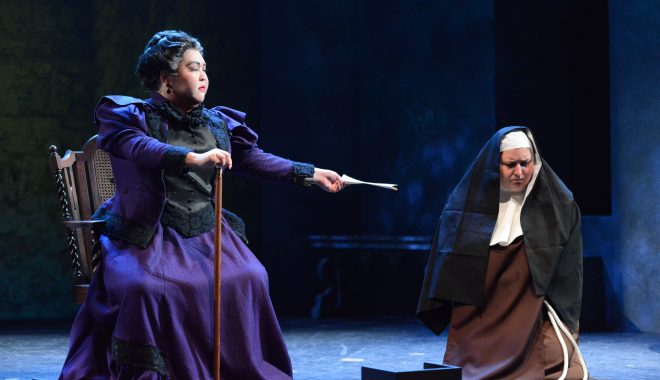
Puccini: Suor Angelica and Le Villi. Academy of Vocal Arts, Philadelphia. November 2018.
One hundred years ago — on December 14, 1918 — the world premiere of Puccini’s Trittico took place at the Metropolitan Opera. In celebration, the Academy of Vocal Arts is presenting one third of that trio of one-act operas. It’s a loving tribute, gracefully conducted by the school’s artistic director Christofer Macatsoris.
Suor Angelica is the tragic tale of a young woman who gave birth to a son out of wedlock and was banished to a nunnery by her family. For seven years, Angelica never heard from anyone back home. Then her aunt, a princess, visits and informs Angelica that her child died. Angelica is distraught that she wasn’t present to give the boy her love, and possibly save his life. She decides to commit suicide so she can join her son in heaven. After swallowing poison, she realizes that this act could send her to hell instead of heaven.
A real-life parallel existed with this opera. Puccini’s teenage housemaid Doria had committed suicide by poison in 1909 after Puccini’s wife accused her of having sex with the composer. Suor Angelica’s libretto is by Giovacchino Forzano, an Italian playwright and director.
In 1918 Puccini was the most popular living composer of opera. In fact, probably the most famous of all living composers, because Claude Debussy had died in March of that year. He was exploring new directions with the Trittico, which included this mixture of spirituality and tragedy alongside the moody precursor of doom-laden film noire called Il tabarro (The cloak), and the comedy about a rogue, Gianni Schicchi.
I had the privilege of talking with Margarete Belleri, a soprano who was one of the nuns in the 1918 premiere. (Her husband was a member of the premiere cast of Puccini’s previous opera, La Fanciulla del West.) She told me how the singers struggled to achieve the somber tone and to accept the progressive harmonies with which Puccini was experimenting. He was introducing chords with a stark contrast between bottom (accompanied by bassoon) and top (with flutes and piccolo) which created a mood of disorientation.
The title role was played by Geraldine Farrar, whom Belleri described as one of conductor Arturo Toscanini’s lovers. In the AVA production, Claire de Monteil alternated with Renée Richardson in this part. I saw the first-year AVA artist Richardson who sang sensitively, with lovely phrasing. The Principessa was Chelsea Laggen, another first-year artist, who made a great impression with her statuesque presence, crisp enunciation and powerful mezzo voice.
Once the Principessa confronts her niece, the opera becomes a highly-charged emotional journey, building to a heart-wrenching finale. Angelica’s anguished aria, Senza Mamma (“Without a mother”), and her pathetic Soave Signor mio were impassioned high spots.
But before the entrance of the princess, Suor Angelica is slow-going. A chorus sings a hymn to the Virgin, then the nuns make small talk. (Puccini loved to supply local color before getting into plot action.) Director David Gately added, at the start, a group of wounded World War I soldiers being tended in the convent. One is on a stretcher, one with a crutch and one in a wheelchair. It does remind us of the period when the opera was written, and the libretto does mention the infirmary run by the nuns. Gately’s innovation may seem distracting, but it does not interfere with the opera’s plot.
The 34-piece orchestra sounded excellent under maestro Macatsoris, including the sounds of harp and celesta to convey an ethereal mood.
This production pairs Suor Angelica with Puccini’s first opera, written 34 years earlier, Le Villi — a one-acter in two scenes divided by an orchestral interlude (“intermezzo sinfonico.”) Most of Le Villi is conventional, although it does show the composer’s emerging skill for orchestration. Puccini’s vocal writing was not yet individual, and one of his choruses sounds a lot like the fishermen’s chorus from Ponchiella’s La Gioconda.
A village couple is about to be married but the young man, Roberto, is seduced by a siren and neglects his fiancee, Anna, who dies of a broken heart. Anna’s father, Guglielmo, calls upon the spirits of abandoned girls (Villi) to take vengeance, and these ghosts force Roberto to dance himself to death.
Guglielmo sings a lament, Anima santa della figlia mia, with a mature accompaniment that recalls Verdi’s Don Carlo. Baritone Daniel Gallegos sang this strongly. Arias for the tenor and soprano are not very interesting but were performed nicely by Matthew White and Kara Mulder. Richard Raub did an expert job displaying the treasures in this score, and led an especially vibrant reading of the intermezzo.
That orchestral interlude depicting a night in a haunted forest took place while captions about the spirits were displayed on a screen. Ideally, choreography would enliven that section. This opera needs to be combined with significant dancing to make its best impression. Here, AVA singers did minimal dancing in the final scene. Sets by Peter Harrison were a simple village square and haunted forest.
AVA performed the other two parts of Puccini’s Trittico in 2016, as reported here.